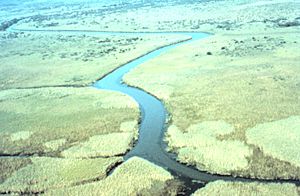Apalachicola National Estuarine Research Reserve facts for kids
The Apalachicola National Estuarine Research Reserve is a special protected area in Florida, a state in the United States. It helps keep the Apalachicola Bay healthy and full of different kinds of plants and animals. It also makes sure that people can continue to use the natural resources in a smart way.
Contents
What is the Apalachicola Reserve?
The Apalachicola Reserve protects the amazing variety of life in the Apalachicola Bay. It also looks after the natural resources that are important for the local economy. This means it helps keep the environment clean and healthy for everyone.
Why is Fishing Important Here?
Many people in the local area depend on fishing for their jobs. About 60 to 85 out of every 100 people earn their living directly from the fishing industry. Most of this fishing happens right in the reserve's waters.
The seafood caught from the Apalachicola Reserve is very valuable. Fishermen sell their catch for about $14 to $16 million each year. When this seafood reaches stores and restaurants, it becomes part of a much larger industry. This industry can be worth between $800 and $900 million for consumers.
How Does the Reserve Protect Nature?
The Apalachicola Reserve does a lot of important research. A big focus is on managing commercial fishing. This helps make sure there are enough fish for the future. They also study the food chain to understand how everything in the bay is connected.
The reserve checks the water quality regularly to make sure it is clean. They have also mapped the bottom of Apalachicola Bay. This helps them understand the different habitats where creatures live. The reserve uses advanced computer systems called GIS (Geographic Information Systems). These systems help teach coastal managers and visiting scientists about the area's environment.
Learning at the Reserve
The Apalachicola Reserve offers many ways for people to learn. They host guest lectures for the community. They also hold workshops for environmental experts. These workshops help professionals learn how to manage coastal areas better.
The reserve has special educational programs for students from kindergarten to 12th grade. These activities happen both in classrooms and out in nature. This helps young people learn about the importance of protecting our natural world.


